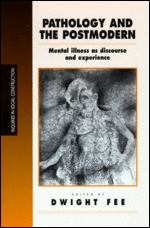

![]()
![]()

This volume certainly works well at systematically addressing, querying and theorising these issues from a number of different angles and sets of concern. Fee establishes early on that the multitude of issues hinges around a central theme: how to emphasise and analyse the discursively constructed and sociopolitically-inflected nature of 'mental illness' without diminishing the experience of disturbing mental suffering as real, with all the lived materiality that implies. How to critique the oppressive (and destructive) imposition of a scientific normative framework (frankly pseudo-scientific as Newman portrays so well in Chapter 12) without reducing interpretive methods to nothing more than relativistic story-telling (which Newman does not portray so well), and equally how to theorise embodied conscious experience without lapsing into some form of biological reductionism? These are the key issues that weave their metaphysical way through what is actually a very grounded collection of chapters focussing on a wide variety of studies on highly specific topics.
A number of authors critique the contemporary configuration of discourse and experience specifically as a condition of our postmodern time. Simon Gottschalk's argument that the very constitution of contemporary subjectivity is inevitably co-emergent with the technologically mediated nature of our social interactions, brings to the foreground the compelling idea of the possibility of a changing form of subjective consciousness. Theories of disorder in modern selves have no role in understanding distress in postmodern selfhood. Gottschalk suggests the term telephrenia to refer to the way 'reality' hallucinated on screens promotes a fragmented and disoriented consciousness. Kenneth Gergen (who coined the term multiphrenia) continues this theme, insisting that postmodernist authors who analyse the loss of the subject (in modernist terms) are not inventing something but are actually theorising a social process. The direction of Gergen's argument is away from despairing at the prospect of a fragmented and groundless self forever lost and phrenic in the networks, and towards the promise of this transformative self evolving into a relational construct of subjectivity. Mark Freeman is not so sure. Through his discussion of artists' 'breakdowns' and the meaning of art through different eras, Freeman is not persuaded that the postmodern condition will provide a springboard to the kind of self Gergen envisages. The artists, whose experiences he describes, are less interested in restoring the self in any form, and are more interested in restoring the other.
A number of authors employ the tools of a postmodernist critique to interrogate the pretensions (and delusions) of establishment science as applied to a number of 'mental illnesses'. Janet Wirth-Cauchon claims that the construct of 'borderline personality disorder' is intelligible as a response to the construct of gender. Jackie Orr describes her highly inventive and risqué research method of impersonating the panic attack patient to precisely research a research programme into the efficacy of pharmaceutical treatment. The use of performative methods leads convincingly to an argument that pharmacological effects may precede the establishment of diagnostic categories. Here we see how the confusions of the mind/body dualism are deeply embedded in the medicalised psychiatry Orr investigates. Fee's chapter on 'Prozac Nation' brings clearly into focus the complexity of current knowledge practices as these are seamlessly interwoven between discourses of scientific expertise and lay appropriations, which in turn reshape abstract systems of knowledge and expertise. Biographies of depression are now playing new roles in constituting self-understandings of depression. Another chapter by co-authors Hewitt, Fraser and Berger, argues that the Prozac phenomenon might be best understood as a means of designing out undesirable personality characteristics to conform to the American ideal of being first and foremost happy, in control, and having high 'self esteem'.
There is a tendency through some chapters to slip between a critique of the dualisms of mind/body, culture/biology and to reduce understandings to cultural constructions that are somehow disembodied. Vivien Burr and Trevor Butt in one chapter, and Jane Ussher in another attempt to outline the dimensions of an epistemology and politics that might avoid this problem which is at the heart of the book's main project. Burr and Butt argue for those aspects of a social constructionist approach that should be retained, while Ussher argues for a critical realist framework that would articulate the interactive pathways between 'material factors', 'discursive factors', and 'intrapsychic factors'. While this material-discursive approach is an important development in moving away from an either/or of discourse or experience, culture or biology, mind or body, like the biopsychosocial model it retains the discrete nature of the domains of 'factors' that then have to be tautologically related to one-another. Steven Sabat and Rom Harré on the other hand, stride into the midst of the empirical reality of brain damage (through Alzheimer's Condition) and language use, without dwelling on the metaphysics of their interpretive frame. They appear to 'do' their analysis from a non-dual frame. We learn how the action of articulating words and the derivation of their culturally-derived conceptual meanings are embodied in the neural networks of the brain, and in being so embodied are no less cultural and no less singular in the moment of their utterance.
Fee states in his introductory chapter that the collection of chapters will conduct a dialogue between the discursive critique of socially constructed knowledges on 'mental illness' and the experiential, phenomenological domain of lived suffering and distress. The book certainly fulfils this aim admirably and is an important contribution to precisely this field of scholarship, opening up new lines of inquiry and debate. I would have liked to see a little more engagement with phenomenological philosophical approaches as these are currently being taken up by researchers concerned to use non-dual epistemologies to generate critical theory (understanding or insight).
Victoria Grace
University of Canterbury